Marko Grujić has been playing on loan for the past three seasons, with the last two spent at Hertha Berlin. After the move to Liverpool in the summer of 2016, the 24-year-old Serbian didn’t really get his chance in Klopp’s Liverpool team, only playing five games in his debut season, and then featuring for U23s. However, after the two seasons of getting regular first-minute minutes in Bundesliga, there is a chance for the former Red Star Belgrade youngster to become a full member of the brilliant Liverpool squad next season. With the regular cluster of Liverpool midfield approaching their thirties, the likes of Grujić can be the type of refreshment Jürgen Klopp might need in his midfield. This is likely the last season of Grujić being loaned out by Liverpool, and he will need to make a decision about his future during the next transfer window. In this tactical analysis, I will try and compare him to current Liverpool midfielders and examine what will be required of him in order to get the chance to play for the first team.
Liverpool midfield
Jürgen Klopp, during his tenure at Liverpool, has been experimenting a lot with his midfield, trying to make the central zone as balanced as possible. In his first seasons, the roles of midfield players were focused more on the attack. However, with the constant evolvement of the team, and especially with the emergence of Trent Alexander-Arnold and Andrew Robertson, the German coach practically abandoned the idea of playing with number ten in a 4-2-3-1 formation. The main job of midfield players in the last two or three seasons has been providing cover for the forwards and full-backs, who regularly go forward. So, there is a lot of emphasis on covering the spaces and pressing, and every candidate for midfield position in Liverpool has to be able to perform these things on the pitch.
This season, the Liverpool midfielders did several things on the pitch regularly that showcased their roles.
The first one is dropping into the backline to form a back-three. Either Jordan Henderson or Georginio Wijnaldum would drop as a right or left-sided centre-back to create one more passing option and have a better position for getting the pass to the flanks for Robertson and Alexander-Arnold. This was especially the case against the teams who play with two forwards. Below you can see an example of midfielders supporting the centre-backs in the build-up, with Wijnaldum acting as a left-sided centre-back:
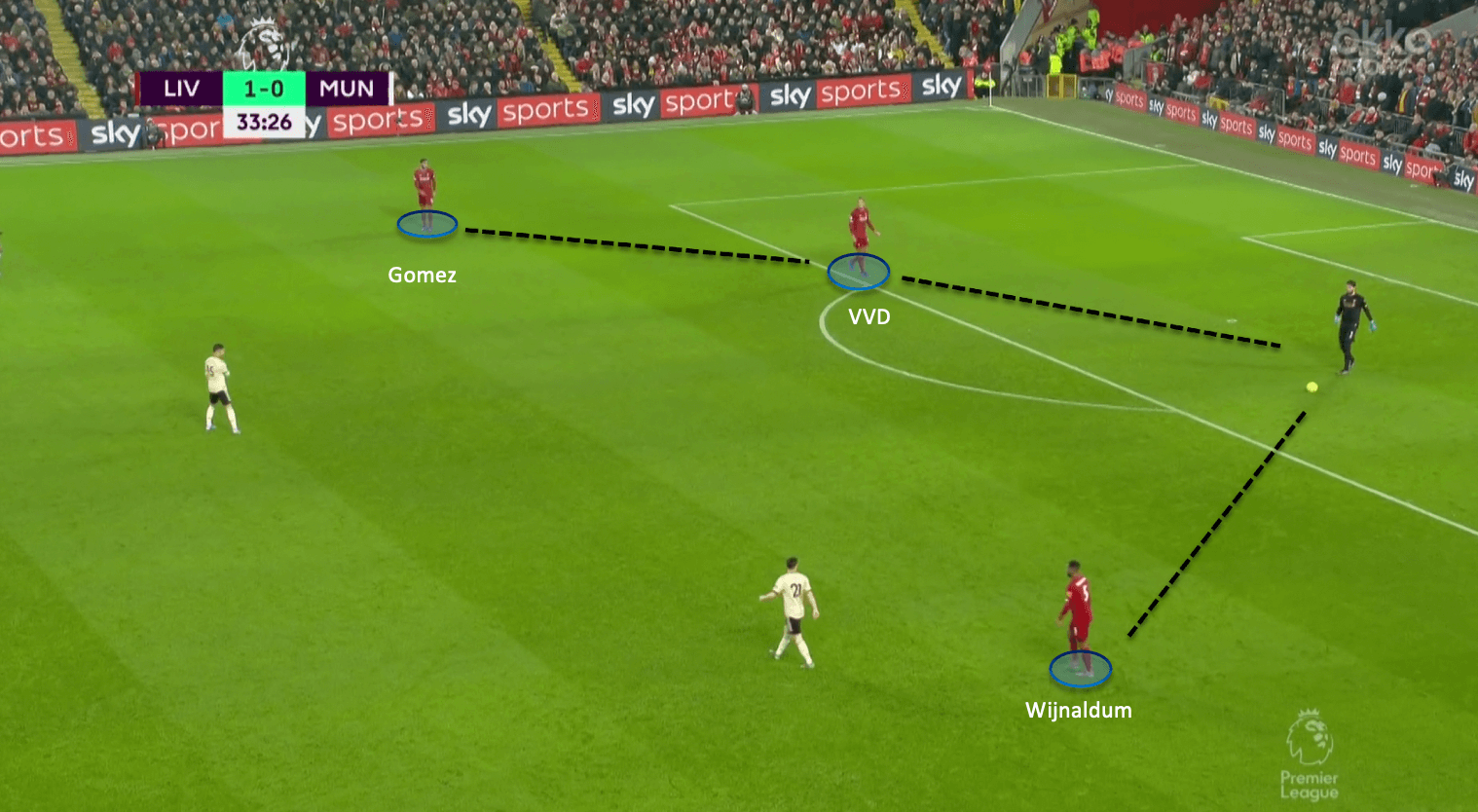
The next pattern is creating triangles on the flanks with the full-back and the winger. This differs depending on the flank as Alexander-Arnold is much more focused on getting the ball into the box or in the areas around it, whether from a deep position or an advanced one. Robertson, on the other hand, relies on passing combinations much more to create space for himself to cross. Thus, Wijnaldum and Sadio Mané help Robertson to work around that side of the pitch to get him into the crossing position, whereas Mohamed Salah on the other flank drives inside and leaves Alexander-Arnold on the flank alone, while Henderson covers space behind the 21-year-old and stays behind a little more often then Wijnaldum does. In the shot below you can see one of the examples, Wijnaldum assisting Mané and Robertson in the passing play on the left flank.
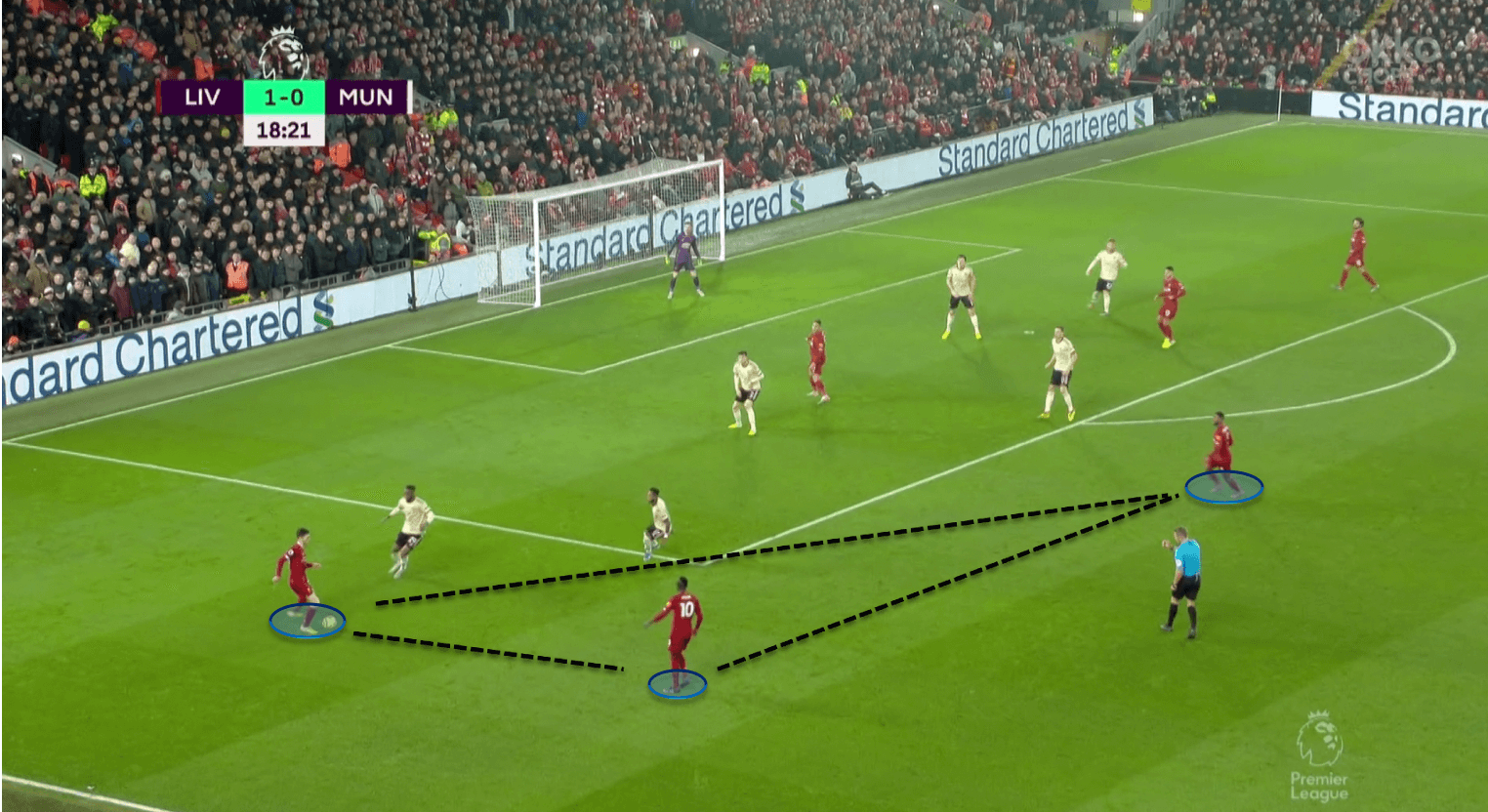
There are also some differences in how both central midfielders participate in attacks. Wijnaldum is one of the best midfielders when it comes to joining the attacks at the second pace, and he is constantly doing that during the games. He is great at finding the right timing of his runs into the penalty area and finding the right spot in the 18-yard-box to have more space. Below is the example of Wijnaldum joining Roberto Firmino and Mané in the box before the first goal against Atlético.
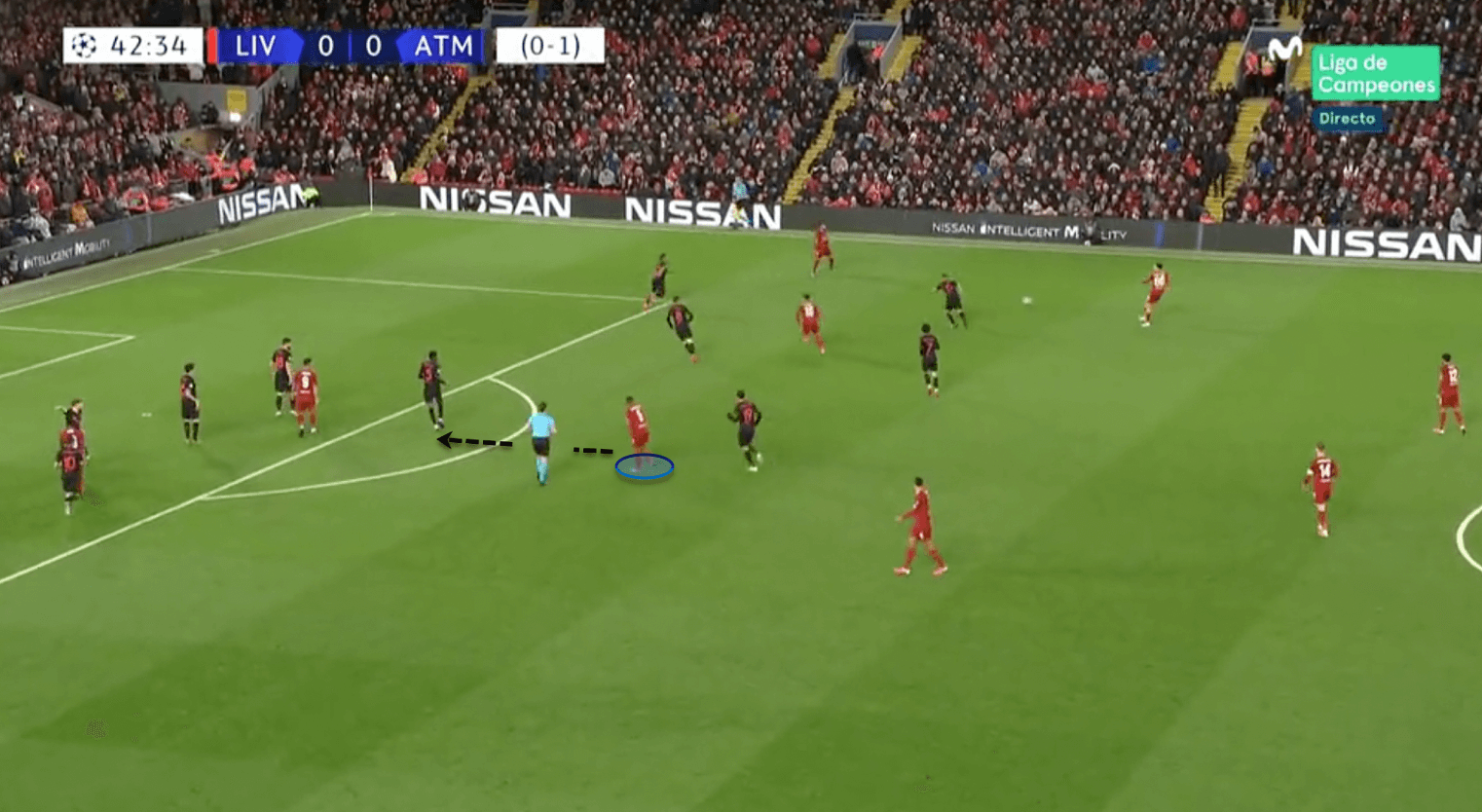
Henderson operates more down the flank in the attack, making the run in the pocket between the full-back and centre-back and then crossing (a good example is his assist to Sadio Mané for the third goal against Manchester City last autumn). On other occasions, he often stays back with the centre-backs to cover for Alexander-Arnold and other midfield players.
When defending, it is vital for Liverpool to move accordingly and cooperate with each other to not leave huge gaps between the players, and midfield is no exception. If the defensive block leans more towards the right, then the left central midfielder needs to get more central. The chemistry between the midfielders and team, in general, is very important, and two regular starters, Henderson and Wijnaldum, have been playing together for almost four seasons. While full-backs provide the width and cause constant danger to the opposition defence, the midfielders balance it out with the great control of the space.
Klopp gets criticized a lot during his time at Liverpool for the constant lack of creativity in midfield, and sometimes rightly so. However, with Liverpool’s focus of attacking through wing-spaces, the main job of midfielders is to close down space behind and to help the attacking group with creating passing combinations, while also being pressing monsters, trying to regain possession as soon as possible.
After such a long time in the club and a handful of transfer windows, Klopp has managed to find a perfect set of midfield players, who suit his system and vision of football well. The two regular starting midfielders, Henderson and Wijnaldum, are both very versatile and can not only play different roles on the pitch depending on the circumstances but different positions as well. Both Wijnaldum and Henderson have played as centre-backs (Wijnaldum against Brighton in 2017 and Henderson against Monterrey last December), as the deepest midfielder and occasionally one of them was playing either as a right-back or as a false 9. They can adapt to their role depending on the tactics of their coach. For instance, in some of the shots above, we saw Wijnaldum dropping deep to aid the build-up, and against Manchester City, he was tracking the movements of De Bruyne the whole game and successfully neutralized the Belgian (as much as you can neutralize him). So, they are versatile and can fill almost every position and role in the central areas. Overall, the balance is what Klopp currently seeks in his midfield, and this is why he prefers the aforementioned duo to more creative players like Oxlade-Chamberlain(former Arsenal) and Naby Keïta.
The attacking style of play
In this section of the analysis, I will go through the main patterns of attacking play that Grujić shows regularly when he is on the pitch.
Regarding his passing, he completes around 41 passes per game with 86% accuracy. His large build helps him in many aspects of his game, including passing and playing under pressure. When receiving the ball from defenders, he tends to go sideways in the vertical direction and play passes to the flanks or through the centre. His skill of shielding off the ball makes it very tough for the opponent to take the ball away from him. Even when he gets the ball facing his own goal he holds his composure and doesn’t give the ball away. Despite his height and apparent slowness, his footwork is decent enough to play with the ball in tight spaces and hold on to the ball, keeping his team’s possession. Below you can examine his sonars in central areas. He passes more to the flanks and diagonally when in his own half, but when he enters the opposition half he becomes more conservative with his passes. Grujić opts for back passes much more, but the tendency of passing to the flanks remains.
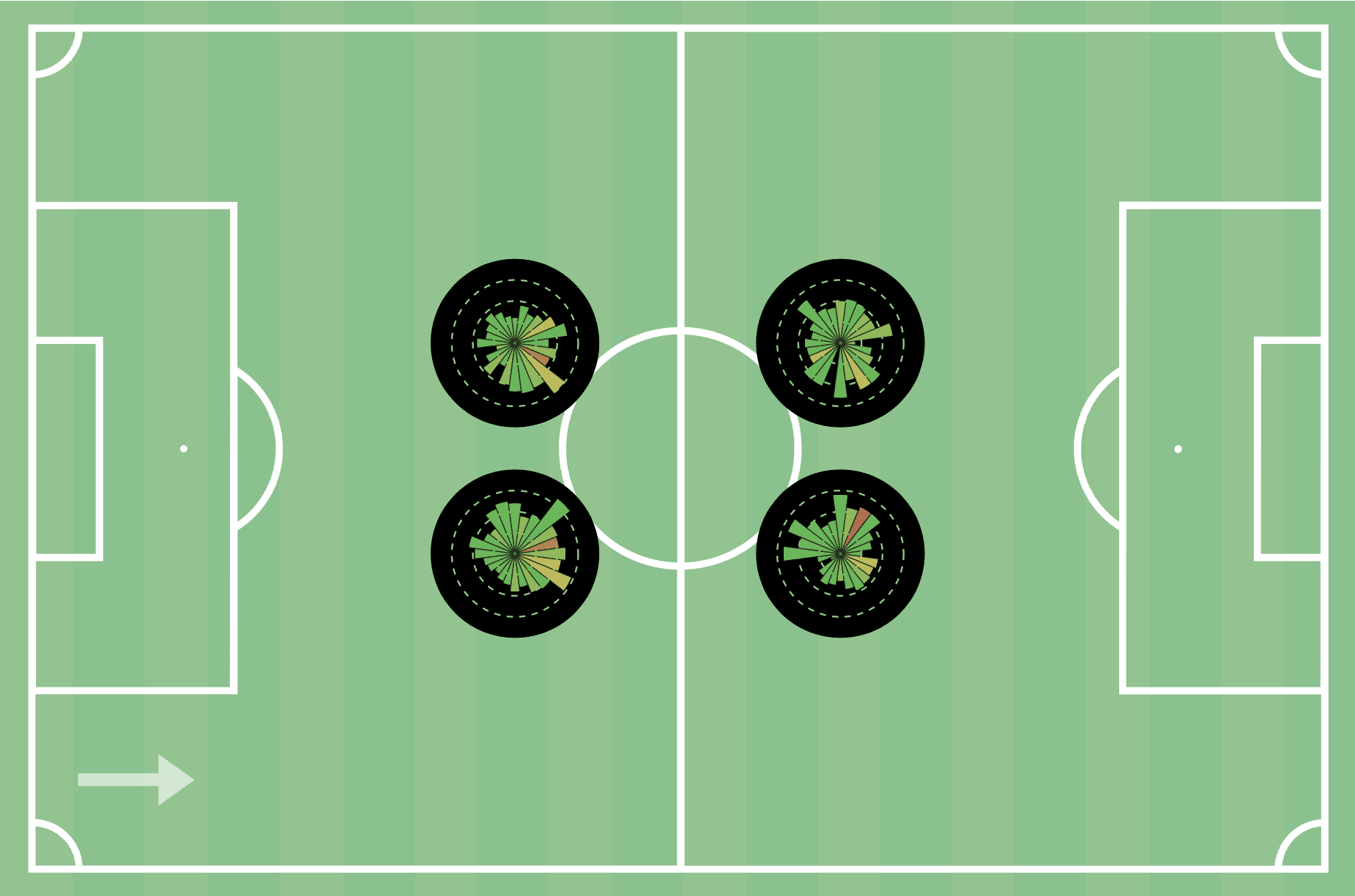
In the shot below you can see that Wolfsburg apply high and intense pressing with five players surrounding Grujić, but he manages to keep the ball and pick a good back pass to the player behind.
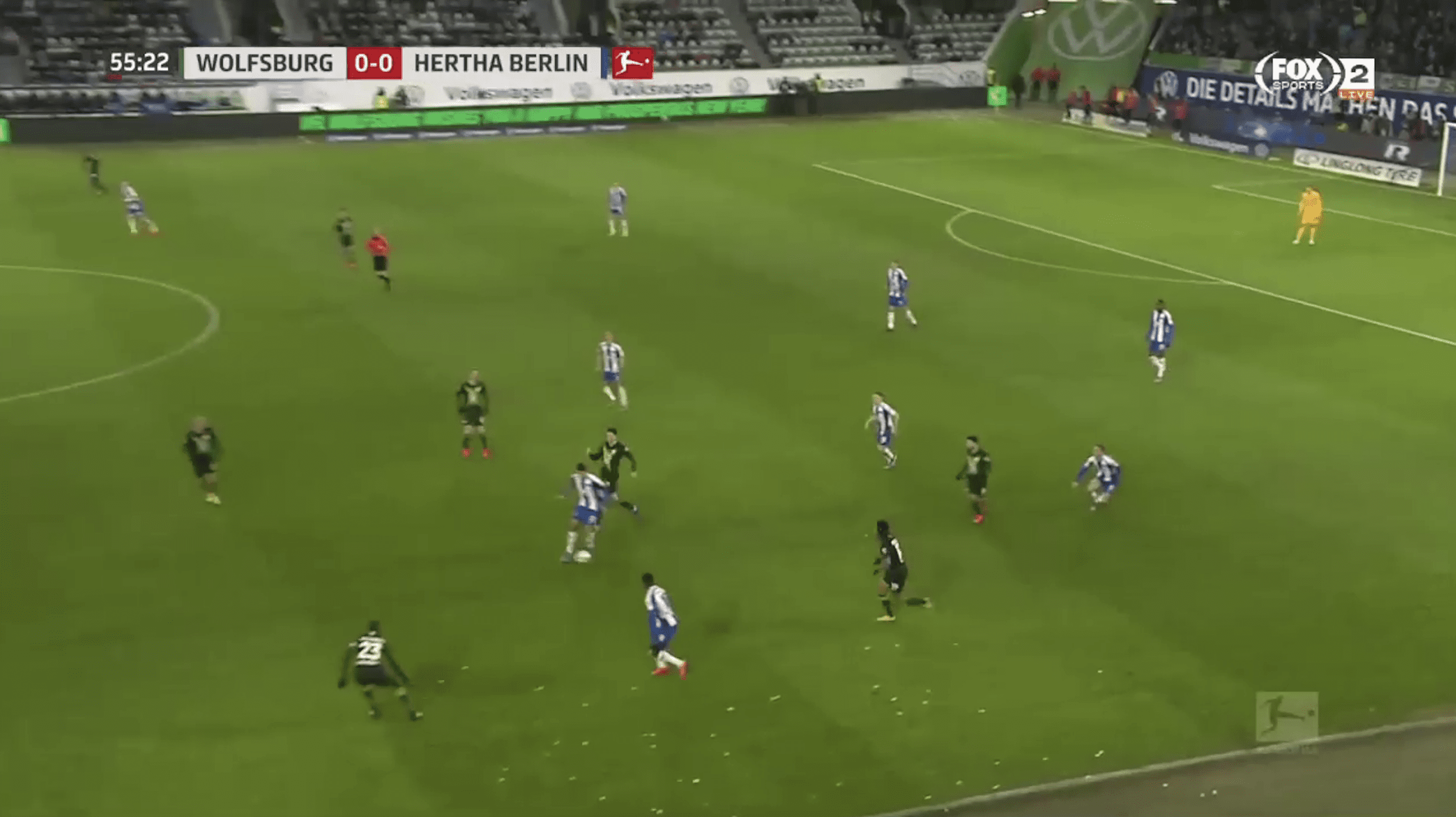
He is also good at long passing, with 2.46 long passes per game and 59.3% accuracy. He switches flanks from very tough situations, like in the image below. He gets the ball after a throw-in and gets the ball across the pitch with the first-touch pass. Grujić switches play from central areas and from the flanks, and this example is very similar to Liverpool’s full-backs switching flanks; one of the full-backs is always unmarked and with the right execution, it can be an effective weapon. So, he won’t be out of place in that regard when playing for the Reds.
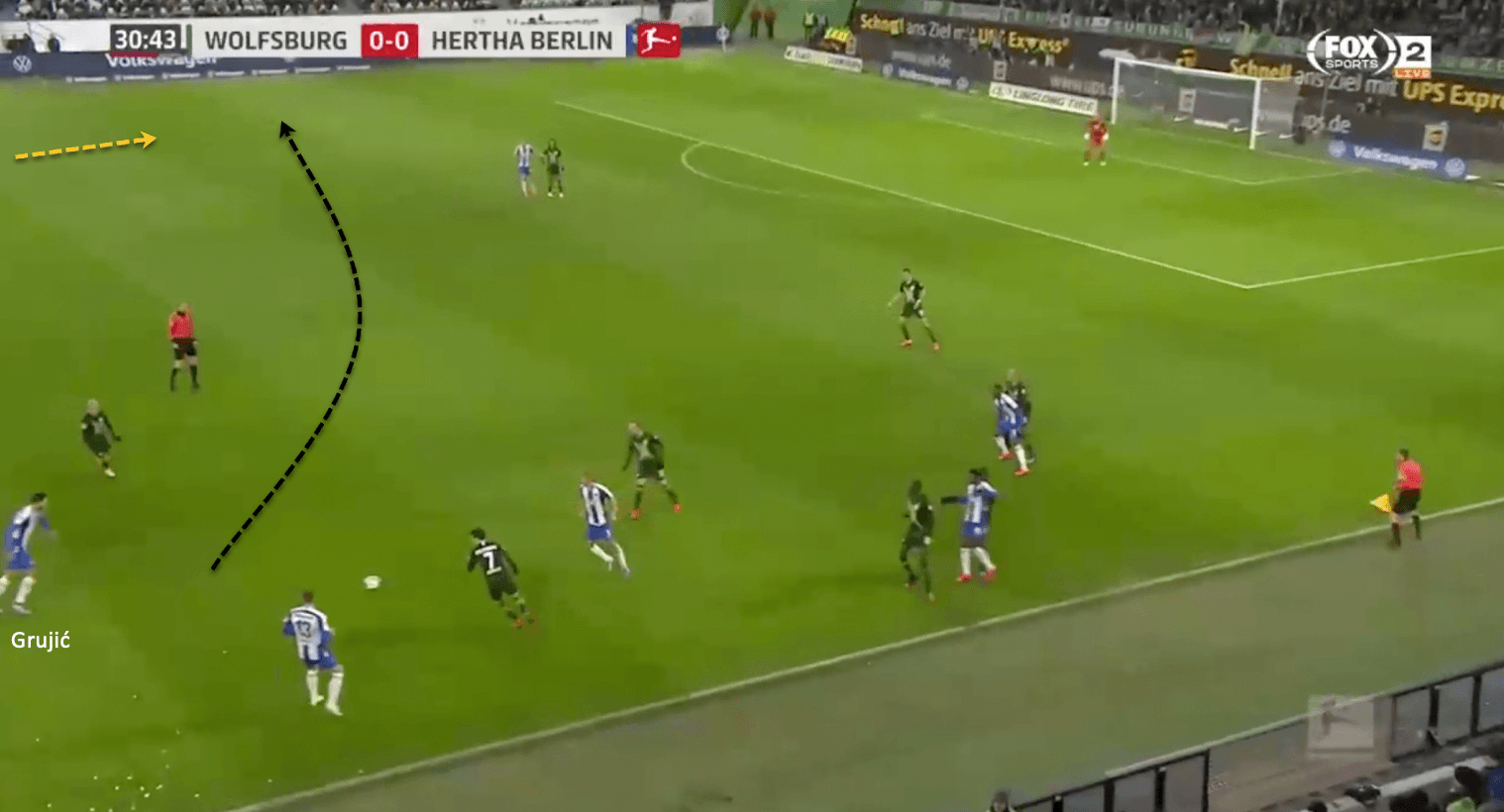
Grujić is a powerful runner with the ball, using his body shape to the full extent in order to get to the position from where he can pick a good pass. He is also good with through passes when he is given the circumstances, like in the example below when he played the striker just onside to get him 1v1 against the goalkeeper. Statistically, his number of through passes is 0.68, and he is not a line-breaker type of midfielder. However, he still can play those passes and put his teammates through on goal.
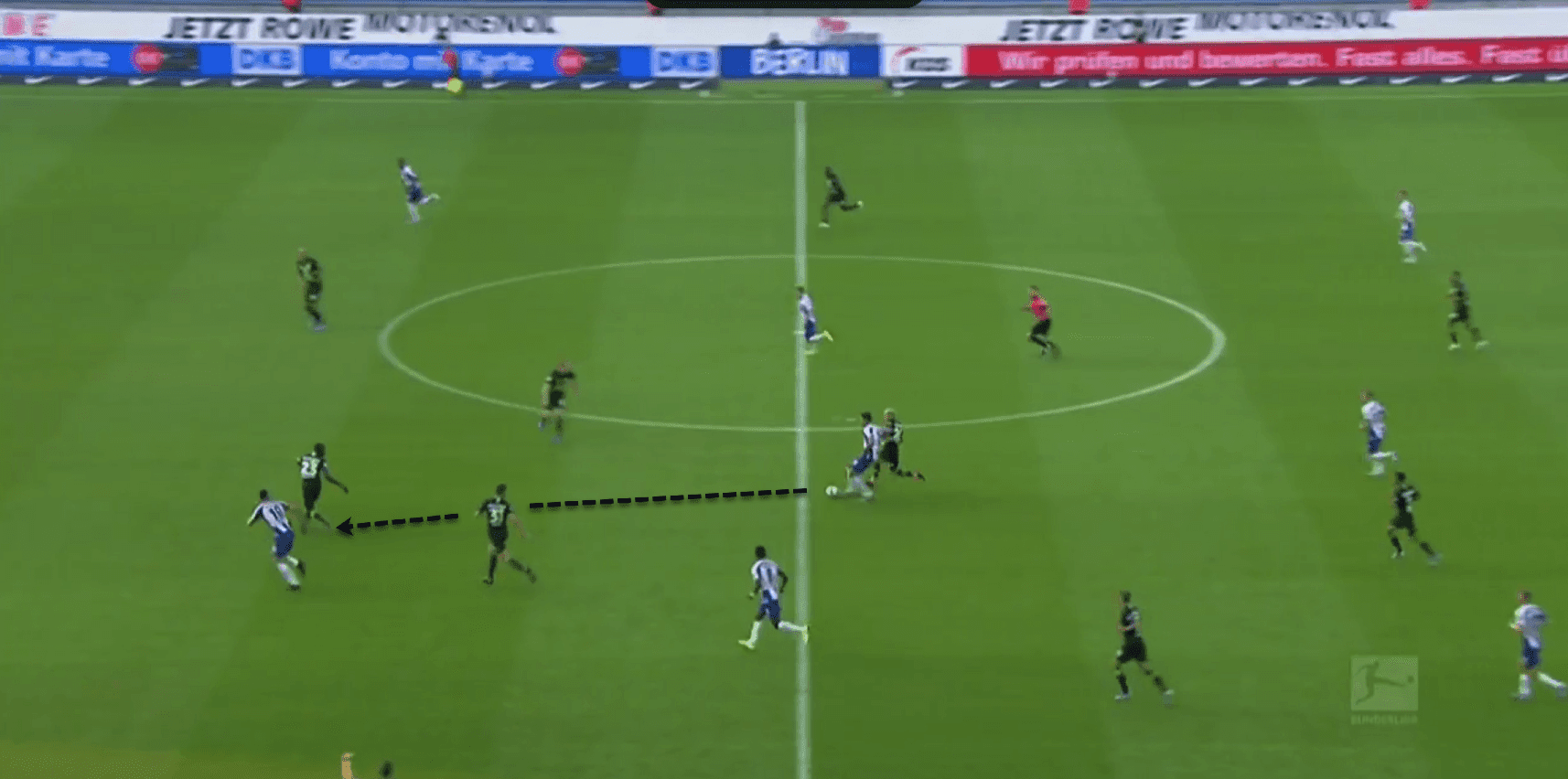
Grujić poses a great deal of danger going forward, not just because of his height and natural strength, but because of his smart movement and positioning. When the team moves upfield, he joins the attack by his runs into the penalty area for crosses or tap-ins. He is good at spotting gaps in the opposition defence and running in them, thus getting Hertha Berlin one more player in the box for their attacks.
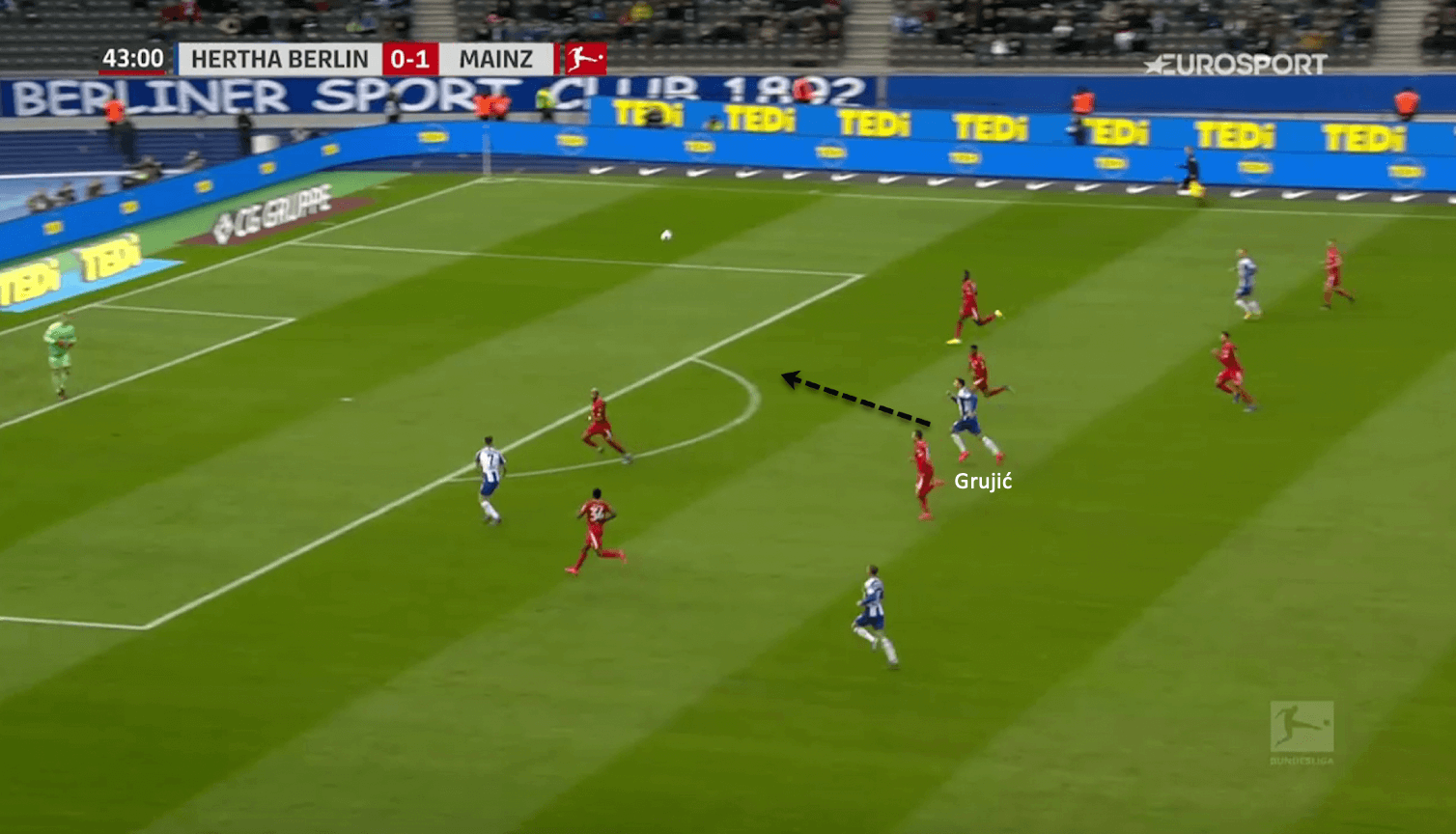
Grujić is 6’2 feet tall, and his presence in the box poses a real threat to the opposition, with the majority of his goals being headers. In the image above you can see the example of Grujić seeing the space ahead of him and making a run in the box, helping Piątek.
With his height, he gives an option for using him as a target-man in midfield, similar to what Milinković-Savić does at Lazio.
In terms of shooting, he averages 1.23 shots per game. He shoots quite frequently from outside the box, you can find his shot map below to see that. He has powerful and accurate shots that most of the time meet the target. However, he hasn’t managed to score a long-shot goal this season yet, all of his four goals came from headers or tap-ins.
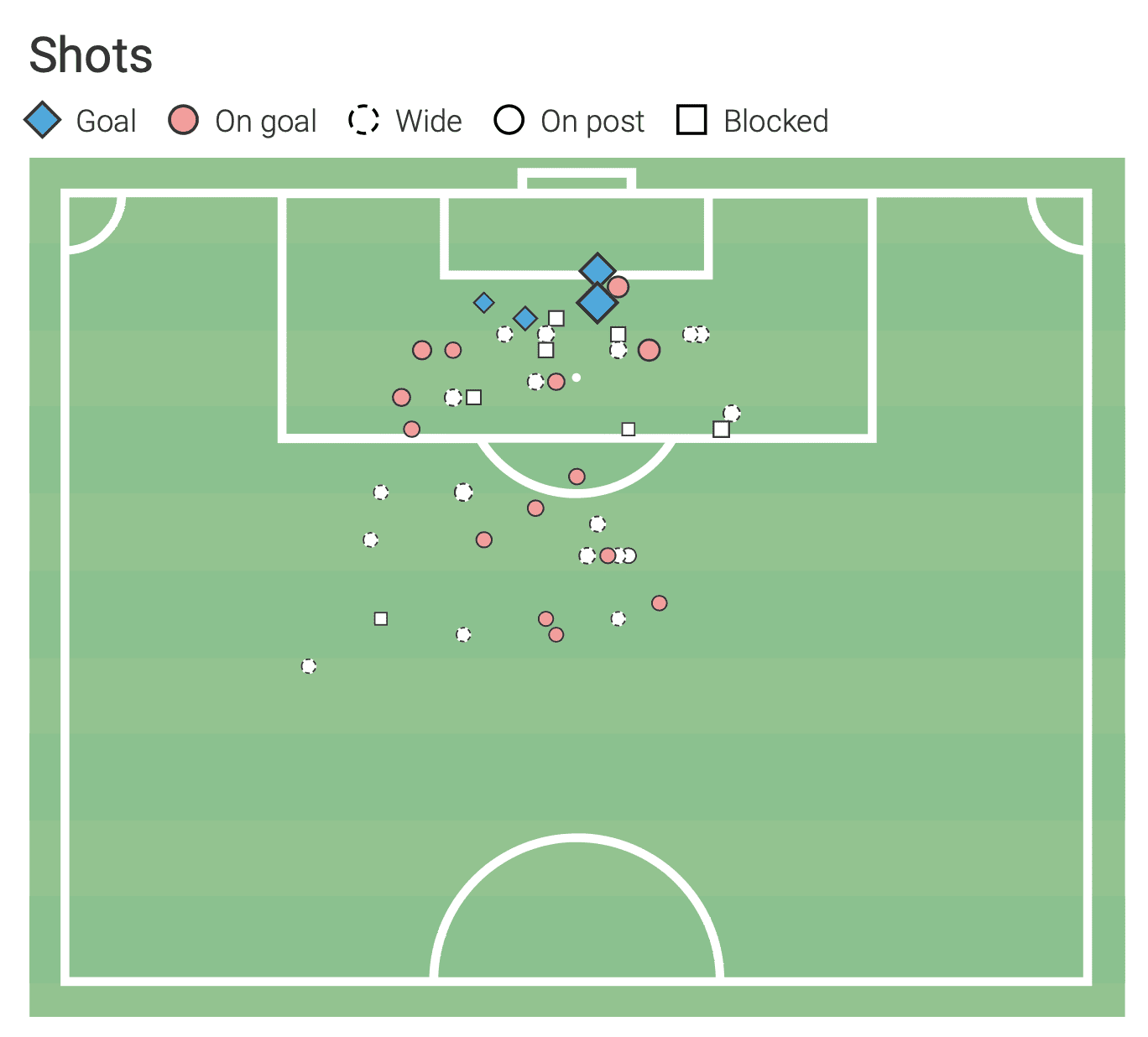
Despite his large build, Grujić has a very solid dribbling technique. He doesn’t let the ball too far from him, and his dribbling ability is decent enough to bypass one or two opponents and create space. His dribbling multiplied by the fact that he is a tough player to push off the ball helps his team win ball progression a couple of times per game. He dribbles 2.1 times with 58.7% of successful attempts, and his ball control can be a big plus for him when he returns to Liverpool. Playing under pressure and good ball retention skills are necessary attributes for a Liverpool midfielder, thus showing that he has it at his disposal on a high level is great for him.
Defending
Having such a height gives immediate dominance in the centre of the park. As I previously mentioned, Grujić is a real asset when it comes to the goalkeeper starting the play and having a good option in the midfield to go long. With 5.29 aerial duels per game and 67% winning percentage, he is a great player to have in the team for long-ball optional build-up or for playing long from a goalkeeper.
Grujić likes to mark his player right when he receives the ball, and apply pressure on the opponent from the back. Having long legs helps him to track the movements of the marked player because he can reach him basically no matter where the marker decides to spin. The same thing applies in the moments where the 24-year-old has to chase his opponent down the flank or when he gets dribbled and has to tackle from the side. He makes 4.79 interceptions per game and 1.95 tackles, 49.74% of which are successful. Grujić has good defensive statistics, and he has some moments of defensive brilliance, but he also has a handful of moments when he is mistiming his tackles or makes unnecessary fouls.
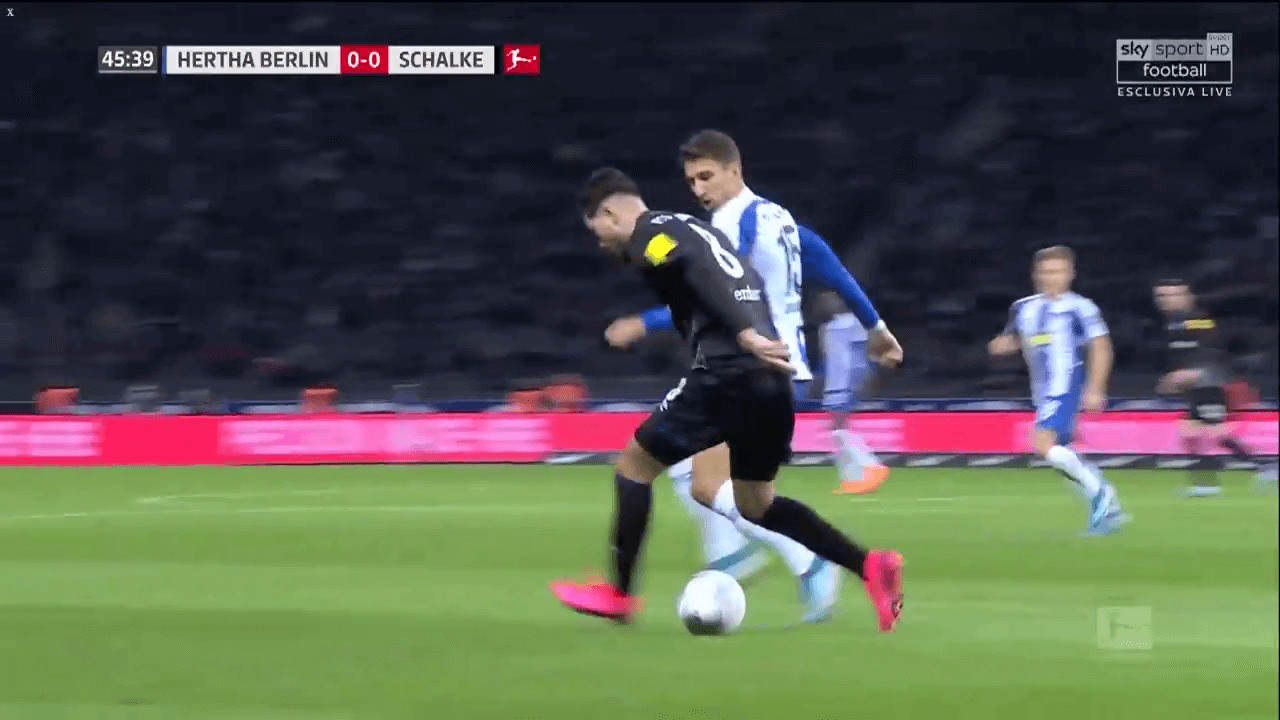
Fouling can be helpful for the team in some cases, but with Grujić it’s not always true. Oftentimes he is too hasty to try and tackle the opposing player, and that leads to many pointless fouls and misplaced tackles. Despite his good agility, he is not quick enough to cope with good dribblers and pacey players in general. If his opponent goes to the side of him with pace, Grujić is often unable to get the ball right away or to track his player further. He tries to tackle from the side, hoping to get to the ball using his long legs, and most of the time it leads either to a foul or to the opponent managing to escape the contact and continue the attack. The Serbian is eleventh in terms of fouls per game in Bundesliga with 2.21.
In the above picture, you can see one of the in-game examples of what I mentioned in the previous two paragraphs. His opponent manages to go a little wide from Grujić, and the latter would lose in pace if they continue like this, so Grujić has to tackle. This way, it becomes a fifty-fifty situation for him. In this example, he managed to stay tight to his opponent, but there are worse case scenarios where he completely misreads the situation and tries to get the ball too late when the marker is already ahead of him. This, as I said, causes many fouls or the cases where he gets bypassed too easily.
I believe that in the right defensive system that suits his playing style, where he doesn’t get exposed 1v1 too often on the flanks against fast players, he can be a solid midfielder defensively. Klopp’s Liverpool has that kind of system, with the right spacing and the most efficient pressing in the world, so I think he has the chance to fit right in, at least as a substitute at first.
Statistical comparison
In this section of the scout report, I will take a look at a couple of statistics to compare Grujić to the Liverpool midfielders that Jürgen Klopp has at his disposal.
In the first graph, we will compare the midfielders regarding their pressing volume by using pressure regains and recoveries. Henderson and Keïta are runaway leaders in both categories, with the Guinean being the pressing machine among the five.
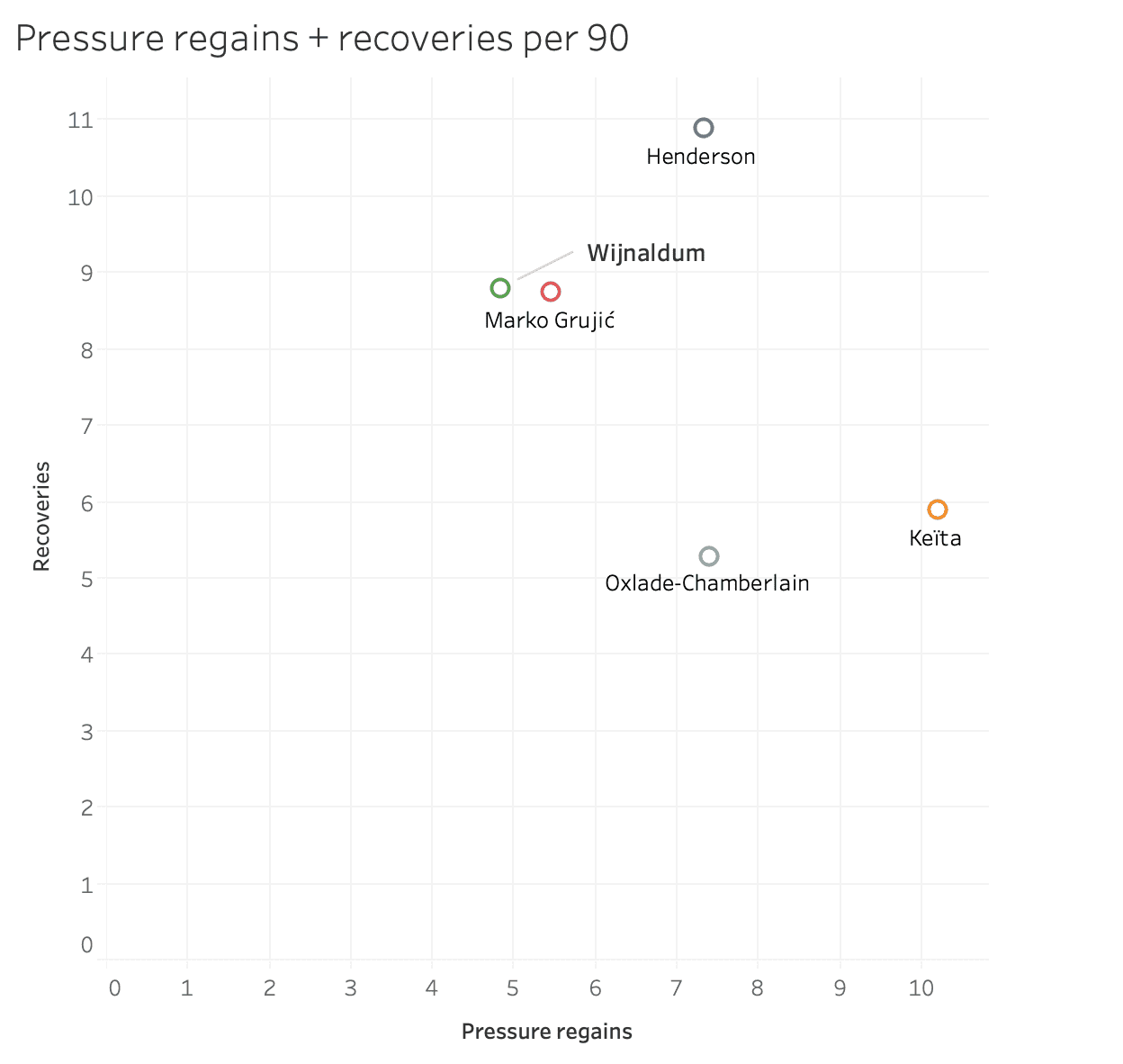
In the second graph, I took progressive runs and passes to examine ball progression. Naby Keïta is, by far, the best midfielder in Liverpool in terms of ball progression and creativity, but it’s important to note that his sample size is quite small compared to the rest of the group. Grujić together with Wijnaldum is not shining in this category, partially because of their roles on the pitch and the focus on the off-ball work.
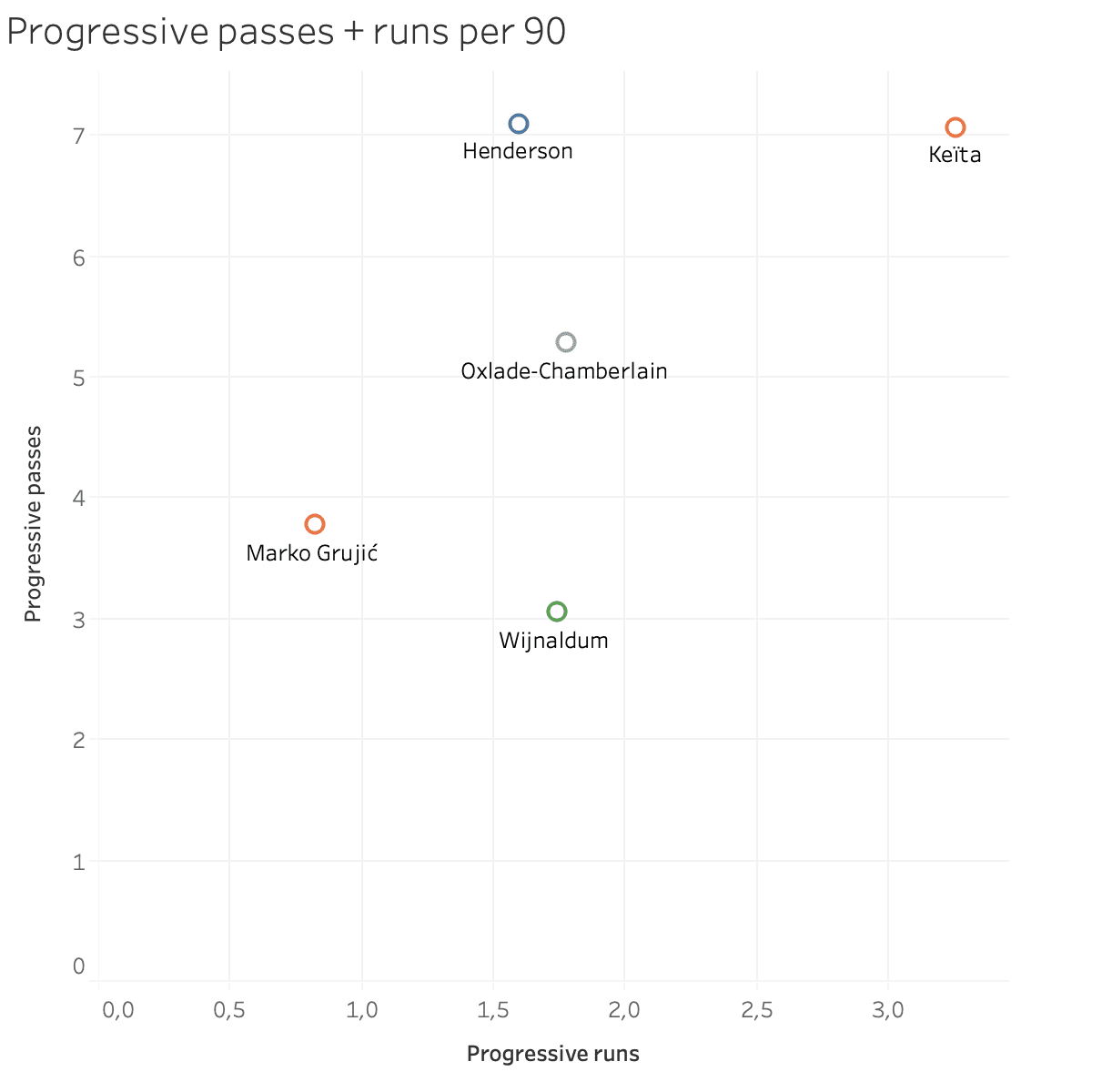
From these two graphs, you can draw the conclusion that Grujić is quite similar to Wijnaldum in his output of pressing and ball progression actions. Of course, it is essential to bear in mind that both are playing in different teams, with a diverse playing style, incomparable amounts of pressing actions that don’t get counted and so on. Moreover, more stats are to be explored before it is safe to say that both are similar in terms of numbers. However, similar levels of output can be proof that Grujić can perform well for Liverpool as he is not that far off from the Liverpool midfielders.
Conclusion
Jürgen Klopp has a very talented and diversified group of players in midfield, and all of them can bring something unique to the table, for example, Oxlade-Chamberlain’s pressing intensity or Wijnaldum’s brilliance when playing without the ball. Marko Grujić can get into the mix too, adding physicality and he is not inferior to his probable competition in terms of link-up play and ball retention. With Adam Lallana potentially leaving on a free transfer in the next window Marko Grujic could be a solid option for his replacement. I believe he fits Liverpool’s philosophy and after playing for such a long time abroad it is fair to say that he deserves his chance to play for the first team. Grujić needs to develop in this well-coached system, and maybe he will clinch a spot in the starting eleven too. He is still only 24 and has plenty of time to evolve into the better player, and it is hard to find a manager better than Jürgen Klopp in that regard.

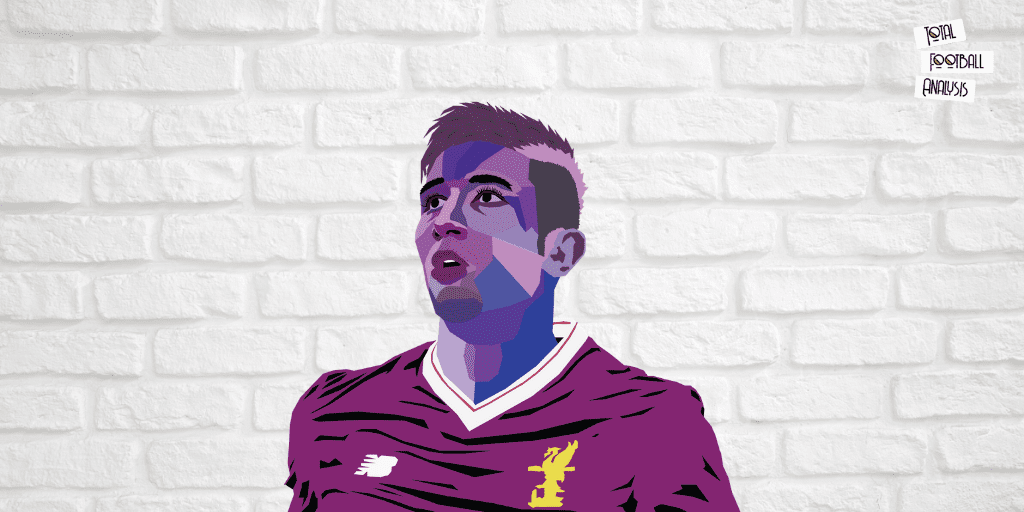


Comments